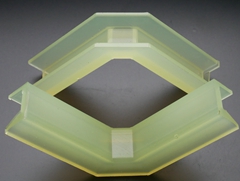Chemical resistance of TPU
 Chemical resistance of TPU
Chemical resistance of TPU
The chemical resistance of TPU includes inorganic
acid-base salts and organic solvents, the latter has the influence of chemical
cross-linking and soaking time, and the comparison of polyester and polyether
TPU.
Acid, alkali and salt resistance
The results show that the hardness, tensile stress,
tensile strength, elongation at break, mass and volume changes of TPU, whether
it is high or low, after being immersed in acid and alkali salts. At 82 (Shore
A), a TPU of 2% to 18% is considered to have a small effect or little effect,
while at 96 (Shore A), a TPU of 2% to 8% is considered to have no effect or
little effect. It can be seen that there is no problem in using these acid-base
salts.
Influence of chemical cross-linking
The TPU structure is MDI/BDO/PBA-1000, the hard segment
content is 26%, and r0=1.0; the TPU is mixed with 2% organic peroxide to
prepare the chemically cross-linked TPU, and the immersion condition is 25℃×7d. The data shows that physically and chemically crosslinked
TPU has severe volume and mass swelling in aromatic ring solvents and
perchloroethylene, and the swelling range is 27% to 237%. However, the swelling
of chemical crosslinking is lower than that of physical crosslinking. TPU;
moderate swelling in methanol, swelling range of 15% to 25%, swelling in
ethylene glycol is very small; in dichloromethane, nitromethane, methyl ethyl
ketone, cyclohexanone, ethyl acetate and tetrahydrofuran , Physically
cross-linked TPU is dissolved, while chemically cross-linked TPU has serious
swelling phenomenon. It can be seen that the solvent resistance of chemically
cross-linked TPU is better than that of physically cross-linked TPU.










